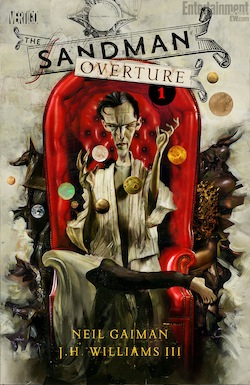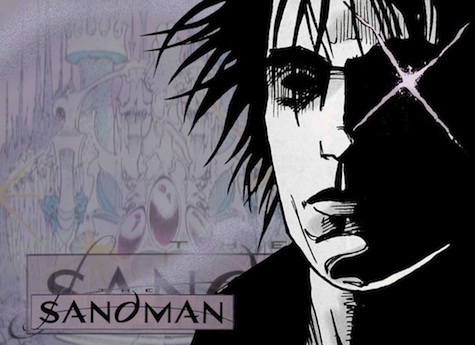Neil Gaiman has never been one for rules. Or rather, he’s never been one for following them: but he certainly loves bending them, breaking them, melting them down into slag, hoisting them up on a flagpole and waving them around for the world to gawk at. Entering a Neil Gaiman story world is like stepping into a dream, where reality unravels and gives way to an eye-popping blend of the mythical, the fantastic, and the plain old strange. His magnum opus, of course, is a story about dreams—and despite breaking every rule in the book, it’s one of the greatest graphic novels ever published.
The Sandman turns twenty-five in January, and it’s about to see its first new issue in almost two decades, with Wednesday’s release of Sandman: Overture #1. When I decided to write about the Sandman series, I figured I’d try to apply the Six Pillars that I occasionally explore in this column. Not surprisingly, that approach fell apart like so much stardust. The Sandman is about everything, and it obeys nobody; the story floats and meanders, moving back and forth in time and space, drifting between mesmerizing dreamscapes. If there’s one thing to be said about this series, it’s that it’s unclassifiable.
Unlike most fantasy, The Sandman doesn’t take place in a fixed story world. Rather, it exists in the realm of dreams and the other realms that dreams touch—which is to say, everywhere and everywhen. A given issue might be set in modern day New York; or in the realm of the Faeries; or in Paris circa the French Revolution; or in the depths of Satan’s hell. Time and place are not what tie this series together; rather, the linking element is that all beings touch the Dream… and that all dreams come from the Dream King.
The Dream King, Morpheus, is the one and only character who appears in every issue of The Sandman, though not always in a starring role. Even he is a bit amorphous, often changing shape, name, purpose, and temperament, depending on who he encounters. He reigns over the Heart of the Dreaming with a strange mix of coldness and kindness, often remaining uninvolved with events, yet occasionally influencing the Dream so as to change world history, or perhaps just the course of one person’s life.
Dream and his six siblings (Death, Desire, Destiny, Despair, Delirium, and Destruction) step front and center during key story arcs. In one early story, Destiny orchestrates events such that Dream goes to Hell to rescue a lover who he cursed to damnation eons ago. While there, he accidentally lets Lucifer quit his job, and it falls on Morpheus to decide who will take over the underworld. He thus receives emissaries from every supernatural plane—from the Norse gods of Asgard, to the Japanese gods of Shinto, to Order and Chaos themselves—in what becomes a political summit of the gods.
Another episode takes place in Elizabethan England, with Morpheus calling in a debt from the young playwright Will Shakespeare. (The debt, of course, is the gift of divine inspiration.) At Morpheus’ request, Shakespeare stages an outdoor performance of his newest play, A Midsummer Night’s Dream, for an audience of the very faeries and magical creatures depicted in the play. As Oberon and Titania watch their on-stage counterparts, Puck the prankster replaces the actor playing his role, and chaos ensues. When all is said and done, the actors are left wondering if the play ever happened at all—which is how A Midsummer Night’s Dream actually ends.
Many of the stories play with history, myth, and fable like this. But others involve less familiar characters: ordinary people remembering childhood dreams, struggling to live up to their own aspirations, or getting pulled by fate into a realm of supernatural happenstance. There’s even an issue about the dreams of cats (they dream of revolt against their human enslavers). In short, few rules apply when it comes to The Sandman. Dreams link the whole saga together… but what is a dream if not the absence of a rulebook?
But what’s most impressive about The Sandman is that there’s an incredible unity to the work. The unifying factor isn’t Morpheus: it’s Neil himself, whose integrity as a storyteller is astounding. His gift for blending imagination with genuine insight into the nature of reality leads to stories that feel both entertaining and important. One of the remastered volumes includes an original script from an early issue, and reading through it, you can see just how closely involved Neil Gaiman was. He didn’t just write The Sandman; he is the Sandman. The series is his dream-child, and that’s what makes this epic saga so powerful and unrivaled.
 If you’ve never read The Sandman, now is a great time to do it. The entire saga has recently been re-inked and re-released in ten gorgeous volumes. HBO is considering a TV adaptation (though according to Gaiman they’ve yet to find a take that works; then again, given their commitment to American Gods, the project remains a possibility.)
If you’ve never read The Sandman, now is a great time to do it. The entire saga has recently been re-inked and re-released in ten gorgeous volumes. HBO is considering a TV adaptation (though according to Gaiman they’ve yet to find a take that works; then again, given their commitment to American Gods, the project remains a possibility.)
And on October 30th, the first of six prequel issues will hit bookshelves, in the form of Sandman: Overture. Dreams may come and dreams may go… but The Sandman is here to stay.
Brad Kane writes for and about the entertainment industry, focusing on storytelling in movies, TV, games, and more. If you enjoyed this article, check out his website, like his page on Facebook, follow him on Twitter, or send him an email at worldsofstory@gmail.com.










